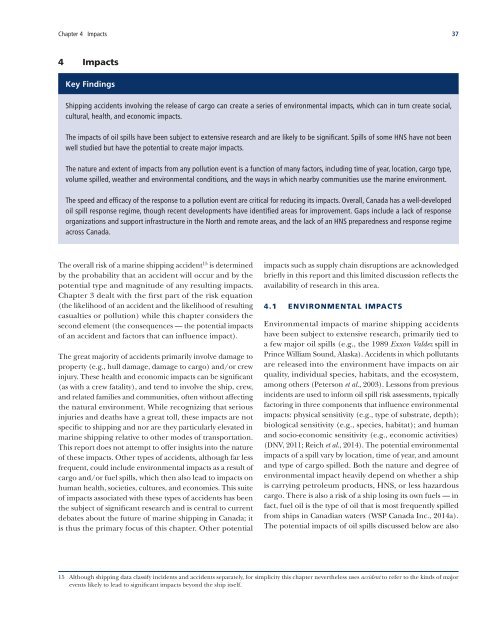Commercial Marine Shipping Accidents Understanding Risks Canada
cca_marine_shipping_risks_en_fullreport
cca_marine_shipping_risks_en_fullreport
You also want an ePaper? Increase the reach of your titles
YUMPU automatically turns print PDFs into web optimized ePapers that Google loves.
Chapter 4 Impacts<br />
37<br />
4 Impacts<br />
Key Findings<br />
<strong>Shipping</strong> accidents involving the release of cargo can create a series of environmental impacts, which can in turn create social,<br />
cultural, health, and economic impacts.<br />
The impacts of oil spills have been subject to extensive research and are likely to be significant. Spills of some HNS have not been<br />
well studied but have the potential to create major impacts.<br />
The nature and extent of impacts from any pollution event is a function of many factors, including time of year, location, cargo type,<br />
volume spilled, weather and environmental conditions, and the ways in which nearby communities use the marine environment.<br />
The speed and efficacy of the response to a pollution event are critical for reducing its impacts. Overall, <strong>Canada</strong> has a well-developed<br />
oil spill response regime, though recent developments have identified areas for improvement. Gaps include a lack of response<br />
organizations and support infrastructure in the North and remote areas, and the lack of an HNS preparedness and response regime<br />
across <strong>Canada</strong>.<br />
The overall risk of a marine shipping accident 15 is determined<br />
by the probability that an accident will occur and by the<br />
potential type and magnitude of any resulting impacts.<br />
Chapter 3 dealt with the first part of the risk equation<br />
(the likelihood of an accident and the likelihood of resulting<br />
casualties or pollution) while this chapter considers the<br />
second element (the consequences — the potential impacts<br />
of an accident and factors that can influence impact).<br />
The great majority of accidents primarily involve damage to<br />
property (e.g., hull damage, damage to cargo) and/or crew<br />
injury. These health and economic impacts can be significant<br />
(as with a crew fatality), and tend to involve the ship, crew,<br />
and related families and communities, often without affecting<br />
the natural environment. While recognizing that serious<br />
injuries and deaths have a great toll, these impacts are not<br />
specific to shipping and nor are they particularly elevated in<br />
marine shipping relative to other modes of transportation.<br />
This report does not attempt to offer insights into the nature<br />
of these impacts. Other types of accidents, although far less<br />
frequent, could include environmental impacts as a result of<br />
cargo and/or fuel spills, which then also lead to impacts on<br />
human health, societies, cultures, and economies. This suite<br />
of impacts associated with these types of accidents has been<br />
the subject of significant research and is central to current<br />
debates about the future of marine shipping in <strong>Canada</strong>; it<br />
is thus the primary focus of this chapter. Other potential<br />
impacts such as supply chain disruptions are acknowledged<br />
briefly in this report and this limited discussion reflects the<br />
availability of research in this area.<br />
4.1 ENVIRONMENTAL IMPACTS<br />
Environmental impacts of marine shipping accidents<br />
have been subject to extensive research, primarily tied to<br />
a few major oil spills (e.g., the 1989 Exxon Valdez spill in<br />
Prince William Sound, Alaska). <strong>Accidents</strong> in which pollutants<br />
are released into the environment have impacts on air<br />
quality, individual species, habitats, and the ecosystem,<br />
among others (Peterson et al., 2003). Lessons from previous<br />
incidents are used to inform oil spill risk assessments, typically<br />
factoring in three components that influence environmental<br />
impacts: physical sensitivity (e.g., type of substrate, depth);<br />
biological sensitivity (e.g., species, habitat); and human<br />
and socio-economic sensitivity (e.g., economic activities)<br />
(DNV, 2011; Reich et al., 2014). The potential environmental<br />
impacts of a spill vary by location, time of year, and amount<br />
and type of cargo spilled. Both the nature and degree of<br />
environmental impact heavily depend on whether a ship<br />
is carrying petroleum products, HNS, or less hazardous<br />
cargo. There is also a risk of a ship losing its own fuels — in<br />
fact, fuel oil is the type of oil that is most frequently spilled<br />
from ships in Canadian waters (WSP <strong>Canada</strong> Inc., 2014a).<br />
The potential impacts of oil spills discussed below are also<br />
15 Although shipping data classify incidents and accidents separately, for simplicity this chapter nevertheless uses accident to refer to the kinds of major<br />
events likely to lead to significant impacts beyond the ship itself.


